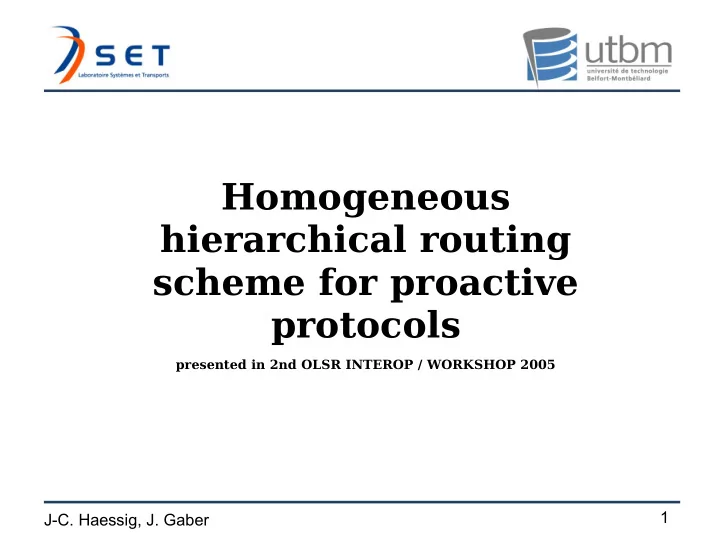

Homogeneous hierarchical routing scheme for proactive protocols presented in 2nd OLSR INTEROP / WORKSHOP 2005 1 J-C. Haessig, J. Gaber
Introduction Ad-hoc networks are usually viewed as small- scale networks. However, future development of mobile communications will require protocols that accommodate with very large networks. 2 J-C. Haessig, J. Gaber
Classical “flat” approach The classical flat addressing and routing approach requires one entry in the routing table for each node in the network. This automatically disqualifies protocols that work this way for large to very large networks. Moreover, testing has shown that most existing protocols hardly sustain networks with more than 500 nodes. 3 J-C. Haessig, J. Gaber
A hierarchical approach To make large networks manageable, a hierarchical scheme is proposed. Nodes will only need to maintain tables to some specific nodes, which will be local area neighbors at the lowest level and distant nodes in the higher levels. 4 J-C. Haessig, J. Gaber
Limited range OLSR Nodes run OLSR in a limited manner and discover neighboring nodes in their area. 5 J-C. Haessig, J. Gaber
Similar node selection Nodes select similar nodes among the ones in their area. 6 J-C. Haessig, J. Gaber
Next-level direct neighbours Selected similar nodes are consided direct neighbors in a new level of the protocol. A new instance of OLSR is launched at this level. 7 J-C. Haessig, J. Gaber
Stacked OLSR Recursively, nodes discover similar neighboring nodes in a bigger, higher-level area. The process is repeated until the whole network is covered. 8 J-C. Haessig, J. Gaber
Similarity The selection of similar nodes need a similarity function that evaluates the level of similarity between two nodes. Similar nodes in an area must be sufficiently scattered to ensure that the protocol works correctly. Therefore, this function must be carefully chosen. 9 J-C. Haessig, J. Gaber
Similarity criterion Suffixes in IP addresses have been chosen because of their availability and because unlike IP prefixes, they are usually distributed randomly. In this proposal, the level of similarity is the number of equal digits of the IP address represented in hexadecimal. 10 J-C. Haessig, J. Gaber
Limiting the size of the local area The size of the area can easily be limited by using a mechanism based on the TTL in Link State updates. A method to dynamically modify the size of the local area is necessary to cope with cases where the physical network is too sparse or too dense. 11 J-C. Haessig, J. Gaber
Impact on routing table size Each node needs only to store routing entries for known nodes in its areas, at each level. The number of levels depends on the size of the addresses. In our case, there are 8 levels because an IPv4 address represented in hexadecimal is 8 digits long. Therefore, the routing tables will be no larger than the number of levels times the area size. 12 J-C. Haessig, J. Gaber
Impact on overhead Basically, in plain OLSR nodes need to send their link state to every other node in the network. With this hierarchical scheme, only the nodes in the local areas (at each level) of a node need this information. Moreover, in higher levels the impact of mobility should be reduced, so the retransmission rates can be lower. 13 J-C. Haessig, J. Gaber
Routing Nodes that want to send a message first check if the receiving node is known in the lowest level of their routing table. If so, routing takes place as usual. If not, the message is sent to one intermediary node in the area of the emitter. The address of this node must be similar to the destination. The message will then be routed in the upper level. 14 J-C. Haessig, J. Gaber
Routing - Example To ease the understanding of the algorithm, let's consider an example on an idealized network. The traffic in the upper level can be considered as “encapsulated”. 15 J-C. Haessig, J. Gaber
Related work OLSR – Optimised Link State Routing. A routing scheme using local areas and two levels has already be proposed in ZRP – Zone Routing protocol, however the second level uses a reactive protocol. FSR – Fisheye State Routing proposed a reduction of route update messages for distant nodes Bit Serial algorithm – the routing algorithm looks like the one used to find a vertex in a hypercube 16 J-C. Haessig, J. Gaber
Further work Further investigation is necessary to discover real-world performance of this protocol. Simulation will provide an estimation of the protocol's abilities Large scales introduces the problem of trust about the data forwarded by neighbors. 17 J-C. Haessig, J. Gaber
Conclusion This hierarchical approach would qualify for large scale networks because it is structurally capable of coping with large quantities of nodes. Also, the homogeneous aspect does not impose additional responsibilities on so-called “clusterhead” nodes in other protocols. Finally, it is possible to implement it in a relatively transparent manner to IP networks. 18 J-C. Haessig, J. Gaber
19 J-C. Haessig, J. Gaber
Recommend
More recommend